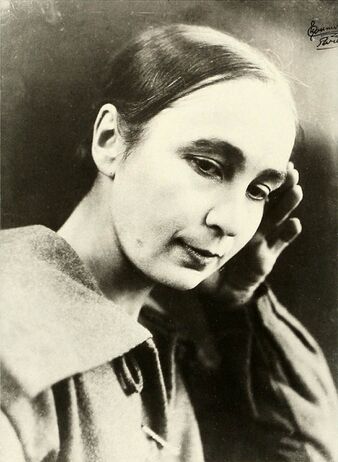Natalia Goncharova
 In Paris, ca. 1915 | |
| Born |
June 16, 1881 Negaevo, Tula Province, Russia |
|---|---|
| Died |
October 17, 1962 (aged 81) Paris, France |
Born Natalya Sergeevna Goncharova in 1881 in the village of Negaevo, in Tula province. 1892-98 moves to Moscow to attend school there. 1900 meets Mikhail Larionov, a fellow student, who encourages her to paint, and he becomes her lifelong companion. 1901 enrolls at the Moscow Institute of Painting, Sculpture, and Architecture to study sculpture. 1906 contributes to the Russian Section at the Salon d'Automne in Paris, but does not accompany Larionov to Paris. 1906-07 begins to work in Primitivist style. 1908-10 begins to work in Cubist style; contributes to the three exhibitions organized by Nikolai Riabushinsky, editor of the journal Zolotoe runo [The Golden Fleece] in Moscow. 1910 with Larionov and others cofounds the Jack of Diamonds group and participates in its first exhibition (Dec 1910-Jan 1911). 24 March 1910 one-day exhibition of Goncharova's work is held at the Society for Free Aesthetics in Moscow; consequently, she was tried and acquited on charges of pornography for exhibiting nude life studies. 1912 contributes to the Der Blaue Reiter exhibition in Munich, and the Second Post-Impressionist Exhibition, London, organized by Roger Fry. 1912-14 The Jack of Diamonds group splits up in February 1912, when she and Larionov dissociate themselves from David Burliuk and the others; she participates in rival exhibitions organized by Larionov: The Donkey's Tail (1912), The Target (1913), and No. 4 (1914). 1912-13 works in Cubo-Futurist and Rayist styles. 1913 contributes to Herwarth Walden's Erster Deutscher Herbstsalon, Berlin. 1913-14 major retrospective exhibitions of Goncharova's work, in Moscow (1913) and St. Petersburg (1914). 29 April 1914 leaves for Paris with Larionov to mount their set designs for Sergei Diaghilev's ballet production of Le Coq d'Or; Galerie Paul Guillaume holds a joint exhibition of both artists' work. 1915 returns briefly to Moscow, where she designs Alexander Tairov's production of Carlo Goldoni's Il Ventaglio at the Chamber Theater, Moscow. 1917 travels with Diaghilev's company to Spain and Italy; settles in Paris with Larionov. 1920s she and Larionov collaborate on numerous designs for Diaghilev and other impresarios. 1920-21 contributes to the Exposition Internationale d'Art Moderne in Geneva (which also includes work by Larionov). 1922 exhibits at the Kingore Gallery, New York (which also includes work by Larionov). 1920s-30s continues to paint, teach, illustrate books, and design ballet and theater productions, including Boris Romanov's A Romantic Adventure of an Italian Ballerina and a Marquis for the Chauve-Souris, New York (1931). 1940s-50s except for occasional contributions to exhibitions, Larionov and Goncharova live unrecognized and impoverished; however, through the efforts of Mary Chamot, author of Goncharova's first major monograph, a number of their works enter museum collections, including the Tate Gallery in London, the National Gallery of Modern Art in Edinburgh, and the National Art Gallery in Wellington, New Zealand. 1954 Goncharova and Larionov's work is resurrected at Richard Buckle's Diaghilev exhibition in Edinburgh and London. 1955 Goncharova and Larrionov marry each other. 1961 Arts Council of Great Britain organizes a major retrospective of Goncharova and Larionov's works. 1962 dies in Paris.
Publications[edit]
- with Larionov and Bogomazov, Oslinyi khvost i Mishen [Ослиный хвост и мишень; Donkey's Tail and Target], Moscow: Ts.A. Miunster (Ц.А.Мюнстер), Jul 1913, 151 pp, JPGs. [1] (Russian)
- with Mikhail Larionov, "Luchisty i budushchniki. Manifest", pp 9-48; repr. in Manifesty i programmy russkich futuristov, ed. Vladimir Markov, Munich: Wilhelm Fink, 1967, pp 175-178. (Russian)
- trans., in Tatiana Loguine, Gontcharova et Larionov, Paris: Klincksieck, 1971, pp 29-32. (French)
- "Rayonists and Futurists: A Manifesto", in Russian Art of the Avant-Garde: Theory and Criticism, 1902-1934, ed. & trans. John E. Bowlt, New York: Viking Press, 1976, pp 87-91, n302. [2] (English)
- with Mikhail Larionov, "Luchisty i budushchniki. Manifest", pp 9-48; repr. in Manifesty i programmy russkich futuristov, ed. Vladimir Markov, Munich: Wilhelm Fink, 1967, pp 175-178. (Russian)
- Eli Eganbyuri (Эли Эганбюри), Natalia Goncharova. Mikhail Larionov [Наталия Гончарова. Михаил Ларионов], illustr. Ilya Zdanevich, Moscow: Miunster (Мюнстер), 1913, 39+54+22 pp. (Russian)
- Misticheskie obrazy voyny: 13 litografiy [Мистические образы войны: 14 литогр], Moscow: Izd. V.N. Kashina, 1914, JPGs.
Catalogues[edit]
- Vystavka kartin Natalii Sergeevny Goncharovoy. 1900-1913 [Выставка картин Наталии Сергеевны Гончаровой. 1900-1913], Moscow: Tipo-lit V. Rikhter, 1913, 11+13+14 pp; 2nd ed., 1913, 12+3 pp. Catalogue of a solo exhibition which displayed 768 works covering the period 1900-1913 and ran from August until October 1913; at the beginning of 1914 it opened in St. Petersburg, but on a smaller scale. The preface is dated August 1913, Moscow.
- Exter, Goncharova, Popova, Rozanova, Stepanova, Udaltsova: Amazons of the Avant-Garde, eds. John E. Bowlt and Matthew Drutt, New York: Solomon R. Guggenheim Museum, 2000. (English)
Literature[edit]
- Miuda Yablonskaya, "Natalya Goncharova", in Yablonskaya, Women Artists of Russia's New Age, 1900-1935, trans. Anthony Parton, New York: Rizzoli, 1990, pp 52-80. (English)
- John E. Bowlt, "Natalia Goncharova and Futurist Theater", Art Journal 49:1 (Spring 1990), pp 44-51. (English)
- Jane A. Sharp, "Nadezhda Udaltsova", in Amazons of the Avant-Garde, eds. John E. Bowlt and Matthew Drutt, New York: Solomon R. Guggenheim Museum, 2000, pp 154-183. (English)
- Anthony Parton, "Goncharova's Rayism", InCoRM 2 (Spring-Autumn 2011), pp 26-33. (English)
- Elitza Dulguerova, "Institution précaire", part 2 in Dulguerova, Usages et utopies – L’exposition dans l’avant-garde russe prérévolutionnaire (1900-1916), Dijon: Les presses du réel, 2015. [3] (French)
See also[edit]
Links[edit]